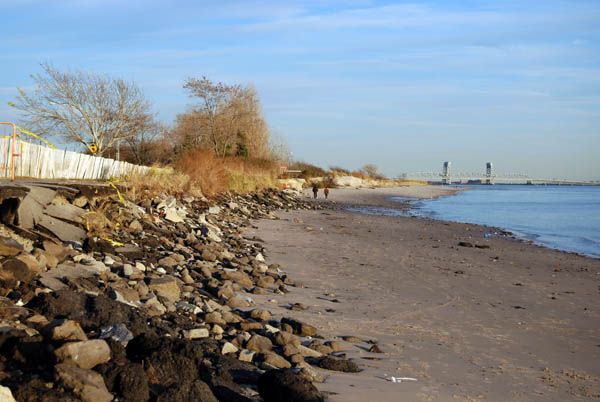Agencies Move Forward With Plans For A Greener Jamaica Bay

Dozens of scientists, educators, environmentalists and public servants met last Thursday evening at Brooklyn College for the third annual Jamaica Bay Research Symposium, a forum focused on issues of water and shoreline health throughout the bay. Jamaica Bay’s history, current state, and future improvement plans – including a new State Department of Environmental Conservation (DEC) and NYC Department of Environmental Protection (DEP) draft agreement to reduce sewer overflows into the water – were discussed.
According to NY1, which covered the symposium, Doug Adamo, a researcher with the National Park Service who has been monitoring the once heavily-polluted bay for 15 years, said at the symposium that while it “has improved considerably since the 1980s,” progress has been slow, and coastal marshland is still disappearing.
“The problem is that we’re losing 50 acres a year, [and] every other year we’re replacing 35, so we still have a big net loss. So, we have a long way to go, but we’re getting there,” said Dan Mundy, a Jamaica Bay advocate.
A major threat to the bay has been wastewater loaded with damaging nitrogen that poured in from five local sewage treatment plants, an issue that city and state agencies have vowed to resolve. DEP officials said that recent retrofitting of those plants has already cut down on the nitrogen, allowing some wetlands to be replaced. Additionally, DEP and DEC reached a draft agreement the day before the symposium to reduce combined sewer overflows into all area waterways.
New York City, like other older urban centers, is largely serviced by a combined sewer system where stormwater and wastewater are carried through a single pipe. During heavy storms, the system can exceed its capacity, and must discharge a mix of stormwater and wastewater into New York Harbor, contaminating water and eroding coastline in Jamaica Bay and elsewhere. Under the new draft agreement, DEP will use green infrastructure to capture and hold stormwater runoff before it enters the sewer system, significantly reducing the amount of overflow into surrounding water by 2030.
“New York City has been using green infrastructure to improve harbor water quality on a small scale basis. New York Harbor is already cleaner and healthier than it has been in more than a century, but our efforts are not nearly done,” said New York City Environmental Protection Commissioner Carter Strickland. “With this proposed agreement, we have laid the groundwork for one of the largest green infrastructure programs in the country … this plan will maximize water quality, sustainability, and affordability for New Yorkers.”
“DEC, the US Army Corps of Engineers, the National Park Service, the City Parks and DEP, [are] all working together … to leverage funding, resources, and scientific information … to come up with a solution,” said John McLaughlin, Director of Ecological Services at the Department of Environmental Protection. “All of that is having a great benefit in the results we’re seeing today.”
DEC is holding a public meeting on the draft consent order on November 9 at 6 pm at DEC’s Region 2 Annex Building, located at 11-15 47th Avenue in Long Island City. Public comments on the draft agreement can be emailed to gekline@gw.dec.state.ny.us or faxed to (518) 402-9029 through November 18.
— Katie McNish



